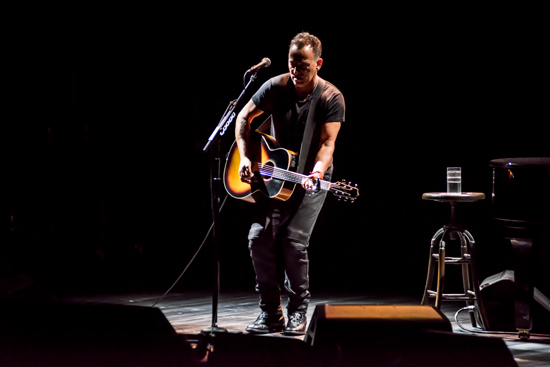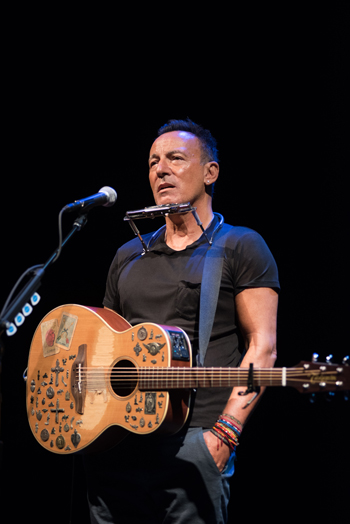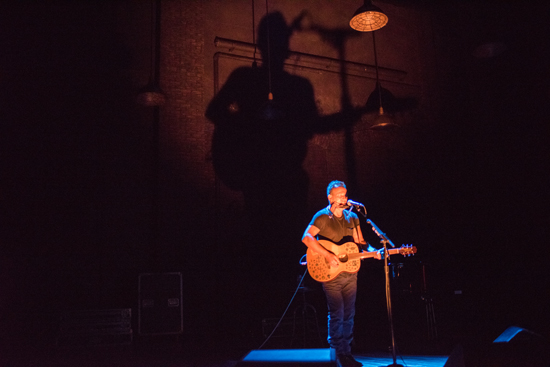
We've got magic to do, just for you
We've got miracle plays to play
We've got parts to perform, hearts to warm
Kings and things to take by storm
As we go along our way
— "Magic to Do," Pippin
From the Magic Rat to "magic in the night" to Magic Street, Bruce Springsteen is no stranger to the conjuring arts. For decades, his concerts have been described as feats nothing short of miraculous, and he has discussed his own songwriting in terms of a magical act: creating, from out of the air, something where there was nothing before. Now he does it again. Written and directed by the man himself, Springsteen on Broadway is an act of alchemy, taking familiar elements — from his songbook, his concerts (particularly his solo tours), his memoir — and combining them, with a new venue, to create something we've never seen before, something that has had preview audiences… well, spellbound.
Opening October 12, the performance starts simply — not with a familiar "Good evening, New York City!" but instead with a list of essentials, stated plainly at center stage. In fact, as simple starts go, this is almost as basic as it gets: "DNA," says Bruce. That is just one of "the elements that will come in handy should you come face-to-face with eighty thousand screaming fans who are waiting for you to do your magic trick. Waiting for you to pull something out of your hat, out of thin air, out of this world…. I am here to provide proof of life to that ever elusive, never completely believable 'us.' That is my magic trick."
With just guitar, piano, harmonica, and a very talented magician's assistant billed as Patti Scialfa Springsteen, Bruce makes good on this implied opening promise. Chekhov would probably agree: if you talk in the first act about having a magic trick, you'd better demonstrate it by the end. And Springsteen doesn't let us down. It's hard to say exactly when it happens — it's a gradual effect, a gathering of forces, a calling-up of spirits, great greasepaint ghosts on the wind — but by the end of this at-times mesmerizing performance we've found that proof of life.
 Springsteen on Broadway is a true theatrical performance, with a script, an arc, and a fourth wall to break. It might have been difficult to imagine this new endeavor as anything but a stay-put solo tour, as a residency. But this is not a series of concerts — it's a one-man show (with all due respect to Patti) that Springsteen has carefully crafted, rehearsed, and honed to perform night after night. It's greasepaint and footlights, without either of those being literally true. Which might not be remarkable for any other extravaganza on the Great White Way, but for an artist who rarely plays the same set twice, who is known, loved, and lauded for his on-stage spontaneity, it might seem a startling change of pace.
Springsteen on Broadway is a true theatrical performance, with a script, an arc, and a fourth wall to break. It might have been difficult to imagine this new endeavor as anything but a stay-put solo tour, as a residency. But this is not a series of concerts — it's a one-man show (with all due respect to Patti) that Springsteen has carefully crafted, rehearsed, and honed to perform night after night. It's greasepaint and footlights, without either of those being literally true. Which might not be remarkable for any other extravaganza on the Great White Way, but for an artist who rarely plays the same set twice, who is known, loved, and lauded for his on-stage spontaneity, it might seem a startling change of pace.
It's not quite a new trick for an old dog, though. The secret that's not quite a secret among Springsteen fans is that his concerts are rarely quite as unscripted as they appear. Sure, he can turn his band on a dime, call audibles left and right, teach his horn section a new song on the fly. But there's also a careful choreography to an E Street Band concert not necessarily evident the first time you see it. The second time you see it, you might be astonished to realize how much is a clockwork part of the show: a shout to the crowd, a spray of water, walking to this side or that, nightly moves and cues that are practiced to maximize the heart-stopping and house-rocking night after night. Springsteen is a showman par excellence. And making things seem spontaneous is part of his job, part of his craft — call it the illusion of the first time. Which makes a Broadway show of this kind a not-so-illogical endeavor.
It all happens on a spare stage. In keeping with his career aesthetic — Springsteen's staging over the years has been minimal, other than the occasional Super Bowl fireworks or mammoth flag backdrop — there's very little to distract from the performance itself. There's not even a curtain. Theatergoers arrive to find the set waiting, all blacks and grays; the dark brick wall in the back, by appearances, could be a freshly painted set or the old bones of the place. There's a barred window stage right; dim, industrial pendant lamps; and most prominently, a grand piano. Heather Wolensky's scenic design evokes a black and white photograph — say, Springsteen photographed by Eric Meola 40 years ago, under a fire escape on a city street. Lighting designer Natasha Katz will soon work subtle wonders with color on this near-black box stage, illuminating that back wall, streaming in like sunlight or like beams through cellar windows. Wrecking Ball imagery also comes to mind, with the tools of Springsteen's trade on view and little else: a couple coiled cables hanging from the wall, monitors and a mic stand. Stacks of black road cases are the closest things to props. The acoustic guitars will come.
Those road cases give the proceedings a backstage ambience and some on-brand cool; they also present some irony. Never has Springsteen been as unpacked or as settled-in for a run of shows. He's going to live here for a while. Given that, this looks like a space that he'll be happy to call home. And he does appear at home in performance here — in Springsteen on Broadway he's our Leading Player, our Stage Manager, talking directly to the audience, cracking jokes, sharing his stories, journeying to spots mystic and exotic (Big Sur with Mad Dog qualifies, right?), all in the service of the most unified narrative he's ever put on stage.
Starting at the very beginning (a very good place to start), the first song out of the gate should come as no surprise for a show inspired by Springsteen's autobiography. It's right there in the title, and Springsteen doesn't resist its natural place in the show: what else could it be but "Growin' Up"? If his preceding "magic trick" litany sounds familiar, it's because you've probably read it: it's part of the foreword to Born to Run, and his memoir's text forms a great deal of the script of the show. Anyone who thought Springsteen might be breaking out his glasses and sitting down to read from the book, however, as he did on stages when promoting his bestseller, will be relieved during the vivid childhood recollections of "Growin' Up" to witness how he interweaves the text with the music. The naturalistic performance establishes the standard operating procedure for the entire evening. He's bringing select portions of his memoir to life, telling a story in words and music to the extent that at times you can't really say where the songs stop and the stories begin. It's all one big story, and one big piece of music.
But what is the story? It may not be what you think — that's another magic trick that Bruce pulls off over the course of the night. Beginning with such straight autobiography that it's almost paint-by-numbers, he engages in some of sleight of hand that brings us somewhere else entirely by the end of the night. It begins subject-by-subject and chapter-by-chapter. From childhood and an Elvis Presley creation myth ("Growin' Up") we move on to look at Freehold ("My Hometown"), his father ("My Father's House"), his mother ("The Wish"). Then there's the freedom of escape ("Thunder Road," sung with great tenderness). Up to this point, the show seems to write itself.

These are stirring, moving performances, each one: the melancholy piano interlude that precedes "My Hometown"; the deftness and humor with which he describes retrieving his father from a bar as a child, the men's broad backs on their stools; his evocation of the stillness of his mother's office at the end of a working day and, repeatedly, the sound of her high heels. The memory of that sound echoes so much through "The Wish," you can only imagine how much it echoes through the writer's mind. Something as simple as the smell of Nescafe coffee in the air, when Bruce describes it at the piano ("Now, when it rains in Freehold…"), carries an evocative ache that you just can't get on the printed page. For Springsteen fans who didn't witness the Christic Institute performances, legendarily Springsteen's first modern revisitation of his material on acoustic guitar and piano — or even for those who did — each one of these is a treasure.
Anyone familiar with Springsteen's songbook — and particularly Chapter and Verse, the autobiography's companion album — might envision the songs that will follow. After tracing some E Street glory (and man, does "Tenth Avenue Freeze-out" on the piano not disappoint, confident and soulful), we'll find ourselves in the realm of "Brilliant Disguise," "Living Proof," and "Long Time Comin'." Right? Yes. No. And no.
It's gradually revealed that the story Bruce is choosing to tell is not that of his biography, his rise to superstardom, or his family, but of his engagement with the world around him. Somewhere in the middle of the evening's performance, after establishing his roots, Springsteen pans back. Linearity begins to drift; eras conflate. This is where the us begins to become believable. He zooms out to tell an American story as much as a personal story, reflecting his own growing awareness of his country and its people, the revelations he met with as he left "the fucking boondocks" to go out into the world, the hopes and promises and challenges and failures of America. The trajectory of Springsteen on Broadway is not so much boy to man, but from the sugar-dusted peaks of his Sugar Pops to the western mountains he recalls vividly from his first journey from coast to coast.
That awakening for Springsteen — to the beauty of America, and to the promises and improbabilities of the American Dream — entered his writing in the late-'70s and early '80s; Bruce himself traces the subject back to Darkness on the Edge of Town. And that's where it appears here, as he introduces a jangly "The Promised Land" with a passage from the book, the most direct "reading" he gives all night. He describes that first cross-country trip, "where I saw the United States at its fullest, and I was overwhelmed by its beauty." It's a good example of the show's deft mixing of moods that, after cracking the audience up with a story of making that haul without a driver's license ("I had never driven a block… I drove halfway across the country, in a '40s manual-transmission truck"), he intones this passage from the book:
The country was beautiful. I felt a great elation at the wheel as we crossed the western desert at dawn, the deep blue and purple shadowed canyons, the pale yellow morning sky with all of its color drawn out, leaving just the black silhouetted mountains behind us. With the eastern sun rising at our backs, the deep reds and browns of the plains and hills came to life. Your palms turned salty white on the wheel from the aridity. Morning woke the Earth into muted color, then came the flat light of the midday sun, and everything stood revealed as pure horizon lowering on two lanes of black and disappearing into… nothing — my favorite thing. Then the evening, with the sun burning red into your eyes, dropping gold into the western mountains. It all felt like home and I fell into a lasting love affair with the desert.
With this riot of color tumbling out, after a black-and-white '50s childhood, it's a Wizard of Oz moment. And it points the way to the rest of the show, where we're not in Freehold anymore. The Vietnam veteran of the "G.I. Blues" bottleneck 12-string "Born in the U.S.A."… the terrors and better angels of "The Rising"… the continuous gauging of our steps up and back in "Long Walk Home"… this trip down the gray brick road is a journey less through his personal life than through the concerns of his work life. He drives it home with "Land of Hope and Dreams," with a segue out of "Dancing in the Dark" that'll make you catch your breath.

Love still plays a part — that, after all, has long been a subject of Bruce's work, too. Midway through the night, he introduces his wife and co-star to blend their voices for two absolutely gorgeous duets: "Tougher Than the Rest" on piano (with a bridge so nice they play it twice), and "Brilliant Disguise" on dual guitars at center mic. Their intimacy points to a real hallmark of the whole night's experience.
For all the comparisons to previous acoustic tours and performances that might come to mind, Springsteen on Broadway is especially suited to one of the smaller houses in the theater district. Springsteen has always been sensitive to venue, showing his love for the old buildings, eschewing newfangled skybox palaces (when he can) for arenas that show their age. Opening in 1921 as The Ritz, the Walter Kerr Theater seats fewer than a thousand — not quite a jewel box, but still a far cry from the arenas of the Devils & Dust tour or even the theaters of The Ghost of Tom Joad, most of which were at least twice this size. The resulting feeling of intimacy accounts for a considerable part of the show's power — it's certainly part of what you're after when you pay your money down — and it's difficult to imagine this performance playing nearly as well in a larger hall. It's tailored for the space. Springsteen rarely if ever moves past the proscenium — he doesn't need to reach out physically into the crowd to generate some connection; it's practically built in. But he maximizes the living room effect, stepping away from the mic at various points to let his voice be heard, unamplified, to the upper reaches.

There's a lot of room up there, for the spirits to swirl. And that's where the magic really comes in, as Springsteen conjures the ghosts not only of his own past, but of our own. And of our present. Of aging and memory. The putting away of childish things. There's so much space, in the songs and the stories, in the building and in the atmosphere Springsteen cultivates, for our own memories to overlay his. Our mothers and fathers, our country, our soldiers, trees in our front yards, our shared histories, these are all in the mix — as is, perhaps most of all, as Springsteen puts it, "waking from the youthful spell of of immortality." One of the most common experiences you're bound to hear following a Springsteen on Broadway performance is that of tears welling up. As the old saying goes, "You'll laugh, you'll cry…." and it's a hoary cliché, but it also means this Broadway upstart is doing it right.
That shared experience reaches its peak with the final song of the night, "Born to Run" on acoustic guitar. It's a song that for so many fans stirs up memories of countless nights with the E Street Band, in encore delirium — or perhaps a version very much like this one in 1988 — and it's long been one of the most communal experiences you'll find. On Broadway it's a celebration, a benediction, an elegy, a commitment, a thank you, and a statement of community, Springsteen's palm finally beating out that proof of life before the lights go out.
Another way Springsteen might describe his magic trick — or love, or a band, or rock 'n' roll — is the equation "one plus one equals three." He borrows the notion from his own "Frankie Fell in Love" and repurposes it during this performance, suggesting that logic doesn't always apply when it comes to extraordinary phenomena like these. It's when you get into the world of miracles, even everyday miracles. What Springsteen on Broadway demonstrates, as his performances have for decades, is that the equation actually makes sense — that in this kind of setting, something extra can happen so that there is a third thing, a bigger thing. You plus me equals us. The mathematical proof for that may be beyond us, but it'll be thrillingly demonstrated nightly on 48th Street.
- Christopher Phillips reporting - photographs by Rob DeMartin
Setlist:
Growin' Up (guitar)
My Hometown (piano)
My Father's House (guitar)
The Wish (piano)
Thunder Road (guitar)
The Promised Land (guitar)
Born in the U.S.A. (guitar)
Tenth Avenue Freeze-out (piano)
Tougher Than the Rest (piano) - with Patti Scialfa Springsteen
Brilliant Disguise (guitar) - with Patti Scialfa Springsteen
Long Walk Home (guitar)
The Rising (guitar)
Dancing in the Dark/Land of Hope and Dreams (guitar)
Born to Run (guitar)






